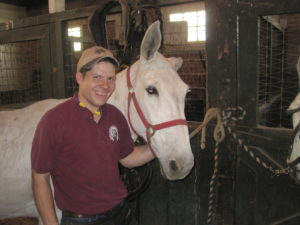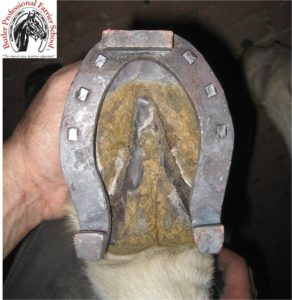Mule Foot Care
 This week (22 Jul 2018), a mule named Wallace the Great made headlines by being the first mule to win a British Dressage competition. Earlier this month, the British Dressage Board revised the rule book to allow mules to compete in British Dressage. Mules have been allowed to compete in dressage in the United States since 2004, but only a few have made it into the higher levels of the sport.
This week (22 Jul 2018), a mule named Wallace the Great made headlines by being the first mule to win a British Dressage competition. Earlier this month, the British Dressage Board revised the rule book to allow mules to compete in British Dressage. Mules have been allowed to compete in dressage in the United States since 2004, but only a few have made it into the higher levels of the sport.
Dressage is a sport that involves very precise training and movement, almost like ballet. In fact, some refer to dressage horses as the ballet dancers of the horse world. Most dressage horses are large Warmbloods. Mules were not allowed to participate in the sport for so long because they were not recognized as horses. The new wording in the rule book says that as long as the animal is born of a mare it is okay for the animal to participate in dressage.
Mules are a hybrid result of a male donkey breeding a female horse. Mules have an odd chromosome number of sixty-three (between the mare’s sixty-four and the jack’s sixty-two) that makes them sterile. If a male horse (stallion) breeds a female donkey (jenny), the result would be a “hinny.”
Mules are popular as a breed because it is thought that hybrids possess vigor or strengths greater than those of either parent. Their hardy qualities make them ideal for packing, riding, farming and/or logging. Mules have become popular for other sports like calf roping, team roping, polo, jumping and dressage. There are differing opinions regarding mules’ dispositions. Mules can be stubborn but also extremely intelligent. Mule enthusiasts believe that mules are smarter and more reliable than horses.
Mules require hoof care just like their horse counterparts. However, there are some differences. Mules typically have smaller feet than horses of equal body weight. A 1,200 pound saddle mule may have a 00-size foot compared to a size 1 or 2 on a similar-sized saddle horse. Mules have steep angled feet. When a farrier drives nails in a mule’s foot, it is important to consider the angle of the hoof wall. Nails may have to be angled straight up and down or even angled out of the foot to prevent quicking the mule.

This is a typical mule hind shape. The shoe is fit to the outline of the hoof wall around to the quarter with the heels of the shoe turned out to follow the outward curvature of the hoof at the buttress and clear the frog. This mule pulled a stage coach at Fort Robinson State Park so he was shod with heel calks and a brazed-on toe calk for traction and to make the shoes last longer.
Mules usually have a higher pastern angle than horses. The heels often grow faster than the toe and must be trimmed accordingly. The frog sticks out below the heels, since the buttresses do not project as far back as they do on a horse. The farrier should avoid excessive trimming of the frog and the bars. Shoes should be fit to the outline of the hoof wall around to the quarter. The heels of the shoe are turned out to follow the outward curvature of the hoof at the buttress and clear the frog. Shoes should extend beyond the buttress one-fourth inch or more depending on the hoof’s conformation and slope at the heel. (Chapter 61: Shoeing Mules, The Principles of Horseshoeing (P3), 2004)
Every year in Bishop, California Mule Days celebrates and showcases the versatility of the mule. Part of Mule Days had a shoeing competition. Lee Green and his son, Porter, hold records for shoeing mules in just over three minutes!
Even though mules are said to be less subject to limb and foot problems than horses, precautions should still be taken. It is not as likely, but mules are susceptible to all foot problems that horses are: navicular, ringbone, laminitis and founder. By caring for mules’ feet the same way that we care for horses’ feet, we can increase their chances of longevity and comfort.
Related Posts
-
Whose responsibility is it to clean up after the farrier? Fa...Apr 26, 2018 / 0 comments
-
Last week, a group of scientists discovered that the Przewal...Mar 01, 2018 / 0 comments
-
Right now is a good time to get into the farrier industry. H...Jan 25, 2018 / 0 comments
Blog Categories
- Anatomy
- Best Business Practices
- Conformation
- Current Events
- Customer Service
- Draft Horse Shoeing
- Equine Soundness
- Essential Anatomy Kit
- Farrier Careers
- Farrier training
- Foal soundness
- Horse Care
- Horse Foot Care
- Horse Owner Tips
- Horsemanship
- Horseshoeing
- Horseshoeing History
- Iron and Forge Work
- Student Spotlight
- Uncategorized
- Veterinary Care
Blog Archives
Contact Us
Butler Professional Horseshoeing School
495 Table Road
Crawford, NE 69339
(800) 728-3826
jacob@dougbutler.com
Subscribe to Our Blog
Get Our Free e-Book!
If you think you want to become a farrier (or know someone who does), this book can help you make that decision. Horse owners will learn the importance of choosing a qualified farrier and how to select the “right” one.
[ Get the e-Book Now! ]
- Follow:
